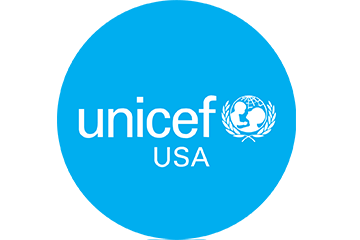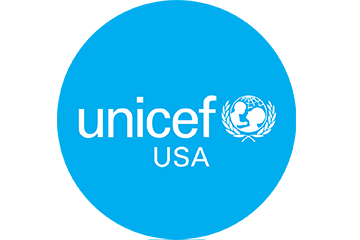Conflict, climate change, poverty and most recently the COVID-19 pandemic are driving massive humanitarian crises, leaving millions at risk of famine. Children are the most vulnerable during periods of famine and extreme food insecurity, facing a greater likelihood of severe malnutrition and death. These crises also produce irreversible, life-long consequences for children, leading to severe health and development challenges.
When we think of famine, we often think of a lack of food. But increasingly, the crisis is one not only of food insecurity, but also of clean water, sanitation and health care — especially disease prevention and treatment. Water and sanitation are just as important as food for children and families facing famine and food insecurity. Here are four reasons why:
At a site for internally displaced persons in Ethiopia, a UNICEF-supported health worker measures the arm of a child to assess his nutrition status. © UNICEF/UN0631314/Sewunet
1. Disease and malnutrition
Unsafe water and sanitation can lead to malnutrition or make it worse. “No matter how much food a malnourished child eats, he or she will not get better if the water they are drinking is not safe,” says Manuel Fontaine, UNICEF Director of Emergency Programs.
Unsafe water can cause diarrhea, which can prevent children from getting the nutrients they need to survive, ultimately leading to malnutrition. Malnourished children are also more vulnerable to waterborne diseases like cholera. Inadequate access to minimum water, hygiene, and sanitation is estimated to account for around 50 percent of global malnutrition.
Fish are hung to dry along a line in a small fishing community outside the town of Kalokol in northern Kenya. © UNICEF/UNI361793/Sobecki VII Photo
2. Climate change
Climate change and extreme weather events like droughts and floods can deplete or contaminate water supplies. This threatens both the quality and the quantity of the water that entire communities rely on. As families in areas of extreme water stress compete for scarce or unsafe water sources, they are driven from their homes, increasing their vulnerability to disease and protection risks.
Globally, over 1.42 billion people, including 450 million children, live in areas of high or extremely high water vulnerability. The Horn of Africa is facing the worst drought the region has seen in 40 years. Four consecutive dry seasons have driven hundreds of thousands of people from their homes, killed vast swathes of livestock and crops, and fuelled malnutrition.
A woman walks with livestock in Afar in northern Ethiopia. © UNICEF/UN0627369
3. Conflict
Conflict is often the main factor driving the threat of famine, putting strain on food and water supplies, as well as health systems. The war in Ukraine, for example, has driven up food and fuel prices in places where children are already going hungry. And all too often, the human dependence on water has been intentionally exploited during armed conflict, with water resources and the systems required to deliver drinking water coming under direct attack.
Nearly all of the conflict-related emergencies where UNICEF has responded in recent years have involved some form of attack hindering access to water, whether intentionally directed against water infrastructure or incidentally. For young children especially, the consequences of these disruptions can be deadly. In protracted conflicts, children under 5 are more than 20 times more likely to die from diarrheal disease linked to unsafe water and sanitation than violence in conflict.
A child walks among tents at a site for internally displaced persons in Somalia, near the border with Ethiopia. © UNICEF/UN0612969/Rich
4. Displacement
When fighting or drought force people from their homes, children and families become more vulnerable both to abuses and to health threats. On the move, children often have no choice but to drink unsafe water. Makeshift camps set up without toilets become hotspots for disease outbreaks. Children who are already vulnerable are more susceptible to diseases, and are often unable to access hospitals and health centers as they flee. Around 9.2 million people are displaced across the four famine-threatened countries: Djibouti, Ethiopia, Kenya and Somalia.
How UNICEF is helping
UNICEF’s support to children and their families includes immediate lifesaving interventions and building resilience over the long term. Included in these are:
- Working with partners on building resilience for communities affected by high or extremely high water vulnerability, in part through groundwater extraction. Drilling for reliable sources of ground water could transform the lives of at least 70 million children in the Horn of Africa who live in areas where access to water is extremely precarious.
- Exploring longer-term solution through regional initiatives. Safe and sustainable sources of water that prevent illness, withstand the impacts of climate change and allow families to stay in their communities, where children can access their schools and primary health care services.
- Developing monitoring and early warning systems. Timely information that alerts governments and communities to rising risks of climate and environmental and hazards, allowing for immediate action to prevent future crises.
- In Somalia, UNICEF is working with the government and partners to provide vital interventions as part of its response to the drought, including providing Ready-to-Use Therapeutic Food to treat acute malnutrition and micronutrients to tackle deficiencies, as well as counseling to encourage families to adopt practical nutrition and health practices at home. In the first seven months of 2022, UNICEF had also provided more than 864,000 people in Somalia with temporary access to emergency water.
- In 2021, UNICEF reached more than 3 million people in Kenya with access to safe water for drinking, cooking and personal hygiene, provision of WASH supplies, COVID-19 hygiene messaging, household water treatment, hygiene promotion and improved sanitation.
Support UNICEF’s efforts to reach children and families in the Horn of Africa with the humanitarian aid they urgently need. Donate today.
This article originally appeared on UNICEF’s website.
Top photo: A student takes a drink as she washes her hands at the Qansaxleey Primary and Secondary school playground in Dolow, Somalia on Feb. 5, 2022. © UNICEF/UN0591230/Taxta





